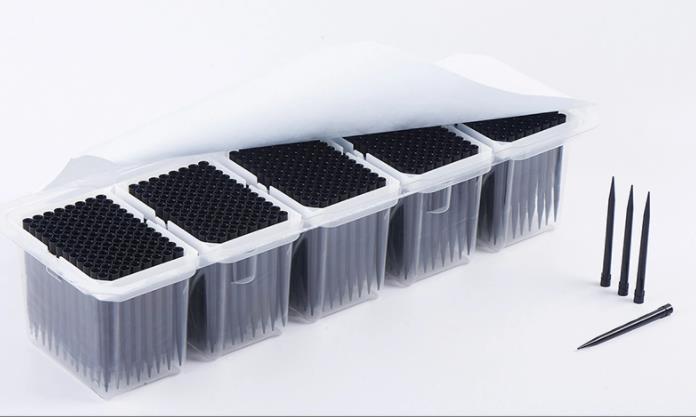The availability of different types of pipette tips, including filtered tips, low retention tips, and extended length tips, allows researchers to choose the most suitable option for their specific needs. These variations offer additional features such as reduced sample loss, improved liquid handling efficiency, and enhanced accuracy.
Overall, pipette tips are essential accessories for pipettes, enabling precise and reliable liquid handling in laboratory settings. They play a crucial role in ensuring accurate results and maintaining sample integrity throughout various scientific experiments and procedures.



Item NO. | Description | Packing Info. | Qty./case(pc) | Case Size(cm) |
D17 | mach with HAMILTON Fully Auto Enzyme Immunoassay Analyzer | (Rack of 96pcs*5)/Unit Box*8 | 3840 |
Pipette tips are small detachable attachments used with Pipettes to dispense and transfer precise volumes of liquid in laboratory settings. They are designed to fit securely onto the Pipette shaft and create a seal to prevent leakage and maintain accuracy.
Polypropylene Pipette Tips: These are the most common type of pipette tips and are usually used for general applications. They are autoclavable, economical, and come in a wide range of sizes and volumes.
Low-Retention Pipette Tips: These tips are specially designed to reduce sample loss by minimizing liquid adherence to the tip's inner surface. They are ideal for working with expensive or precious samples, as they ensure accurate and precise transfers.
Filter Pipette Tips: These tips have built-in filters that prevent aerosols, contaminants, or particles from entering the pipette shaft, thus protecting both the sample and the pipette from contamination. They are commonly used in PCR, molecular biology, and cell culture applications.
Extended Length Pipette Tips: These tips have longer, narrower tips that are useful for reaching deep and narrow vessels, such as tubes or vials, without touching the sides.
Conductive Pipette Tips: Used for electrostatic-sensitive samples, these tips are made of conductive materials that eliminate the risk of electrostatic discharge.
When selecting pipette tips, consider the following factors:
Type of Experiment: Consider the type of samples you will be working with and the specific requirements of your experiment, whether it's general lab work, molecular biology, cell culture, or PCR.
Pipette Compatibility: Ensure that the pipette tips you choose are compatible with the brand and model of your pipettes. Different brands may have unique designs and dimensions that require specific tips for proper functioning.
Volume Range: Select pipette tips that accommodate the volume range you will be working with. Choosing the right size is crucial to prevent tip leakages and inaccurate measurements.
To ensure accurate and reliable results, it is important to use pipette tips correctly:
Check Integrity: Before use, visually inspect the pipette tips for any cracks, deformities, or contamination. Discard any damaged or compromised tips to prevent errors and contamination.
Proper Attachment: Make sure the pipette tip is firmly and securely attached to the pipette shaft. A loose or improperly attached tip can lead to leakage and inaccurate measurements.
Pre-Wetting: Pre-wet the pipette tip by aspirating and dispensing the liquid without touching the sample vessel. This helps ensure accuracy by removing any air bubbles or liquid remnants from the tip.
Correct Technique: Follow the manufacturer's instructions on the proper technique for aspirating and dispensing the sample. Use smooth, consistent motions to ensure accurate liquid transfers.
Proper Disposal: Dispose of used pipette tips in designated Waste containers to prevent contamination and cross-contamination.
Pipette tips are essential laboratory tools that enable precise and accurate liquid handling. By choosing the appropriate type, size, and material for your application, as well as using them correctly, scientists and researchers can ensure the integrity of their experiments and obtain reliable results. Remember to always follow the manufacturer's guidelines and best practices when selecting and using pipette tips for optimal performance.
Contact: Neo
Phone: 008615867460640
E-mail: Info@Hwtai.com
Whatsapp:008615867460640
Add: Building 2, Xinmao Qilu Science Technology Industrial Park, Tianqiao District, Jinan City, Shandong Province,China.
We chat
